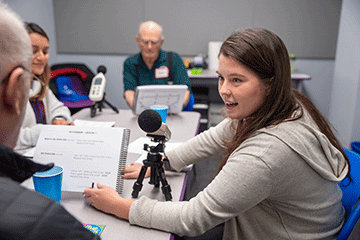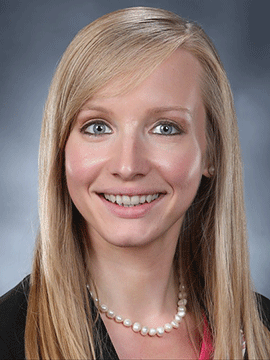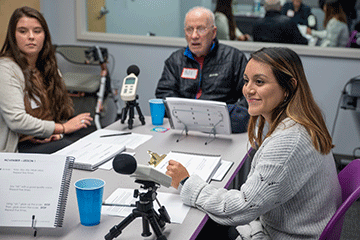
06/27/2023
For individuals with Parkinson’s, one of the most devastating effects of the incurable neurological condition is having their voices slowly fall silent.
“Initially a patient might talk very softly,” said Michele Chisholm Clukey ’14, M ’16, a speech-language pathologist who works at Guthrie Cortland Medical Center. “They are not able to project their voice. They have a hard time communicating with their friends and family.”
Parkinson’s disease affects the nerve cells in the brain that produce dopamine. Symptoms include muscle rigidity, tremors and changes in speech and gait.

Clukey in the past three years has developed a partnership with SUNY Cortland’s Communication Disorders and Sciences Department to help individuals with Parkinson’s regain their voice volume. She closely mentors college graduate students, six to date from SUNY Cortland, and also passes along her hospital patients to her alma mater’s Center for Speech, Language and Hearing Disorders for the maintenance therapy that is not typically reimbursed by health insurers.
In three weekly sessions lasting four weeks, Clukey trains individual patients to raise their voices by speaking with intention, which involves them exercising a part of their brain that is not harmed by the chronic neurological condition, one involving deliberate actions and vocalizations. Then she passes them along to SUNY Cortland graduate students working on their Master of Science in Communication Sciences and Disorders in the university’s Center for Speech, Language and Hearing Disorders for group maintenance therapy.
“At the end of four weeks, their ability to project their voice, make their wants and needs known, has improved,” Clukey said. “They are no longer asked, ‘What did you say?’ all the time. They have a confidence about them that is so much more elevated than it was prior. That’s what makes the therapy exciting, it’s seeing their confidence and their personalities kind of shine out when they are done.”
Both hospital and university are using the SPEAK OUT! ® therapeutic approach that SUNY Cortland introduced locally four years ago, and which has been supported annually by grants renewed by the Parkinson Voice Project (PVP), a Richardson, Texas-based 501(c)(3) non-profit.
Now PVP for a fifth consecutive year has awarded SUNY Cortland’s Communication Disorders and Sciences Department one of its 2023 SPEAK OUT! ® grants, which will train an estimated 23- to 24 incoming graduate students, according to the grant’s administrator at SUNY Cortland for three years, Eileen Gilroy, externship coordinator, clinical educator and a lecturer IV in communication disorders and sciences.
“This year’s grant funded the training for all incoming graduate students and two clinical faculty members, and supported the purchase of enhanced lighting for tele-practice sessions,” Gilroy said.
To continue receiving the grants, SUNY Cortland faculty collaborate closely with PVP to keep everyone up to speed, Gilroy noted.
Up to 90% of people with Parkinson’s are at risk of losing their ability to speak, said Samantha Elandary, PVP’s founder and chief executive officer, in announcing the latest year of grants.
“In addition, swallowing complications account for 70% of the mortality rate in this patient population,” Elandary said. “Our vision at Parkinson Voice Project is to make quality speech therapy accessible to people with Parkinson’s worldwide.”
PVP serves 364 clinic hospitals, universities, private practices and other speech therapy clinics across the United States and abroad with the training, workbooks and access to the PVP’s eLibrary.
Cortland’s Center for Speech, Language and Hearing Disorders, operating to the public out of the Professional Studies Building on the main campus, is among only a handful of providers across New York state to offer the program and most are in large upstate urban centers or the metropolitan New York area. Services are delivered in-person at the center or via tele-practice for individuals that reside in New York state.
“One thing I really like about SPEAK OUT! ® that’s different than other treatment protocols is that it includes aspects of cognitive therapy,” Clukey said. “And the general principle that we’re teaching, which is to speak with intent, you can use that in other aspects of your life. You can walk with intent. You can write with intent. So, I think it generalizes better than just a narrowed voice treatment protocol.”
Gilroy said clinicians providing in-person services use a sound pressure meter, which measures the decibel level of the client’s voice, to let the patient know how successfully they are raising the volume of their voice or vocalizing with intent.
“With Parkinson’s patients, their volume declines, and they tend to mumble,” Gilroy said. “We teach them to speak with purpose."
“The whole idea behind this therapy stems from the fact that automatic tasks are harder for individuals with Parkinson's,” added Gilroy’s colleague, Rachel King ’15, M ’17, a lecturer and speech-language pathologist who works with the clients in the initial phase. "So this retrains their brain so they can get used to this new lifestyle and communicate more effectively."
Clients who have rehabilitated their skills graduate into one time weekly SPEAK OUT! ® Groups; however, individual therapy can be extended for those who did not reach their goals, King said.
“Our clients make a lot of progress in that four weeks, with the individual attention and daily working out of their voice,” Gilroy said. “Then, it’s like a gym, if you get to your goal and you don’t maintain it, you’re going to regress.”
The maintenance phase of treatment is called SPEAK OUT! ® Groups, formerly LOUD Crowd. Clients practice their new skills together in a weekly tele-practice group setting.
“The groups are dynamic and fun,” Gilroy said. “Members support each other, and groups have developed a sense of family.”
“What’s a surprise is that individuals who were dependent on a spouse or family member to drive to get them to the clinic can logon to be independent,” she said.
Graduate student clinicians work under the supervision of certified, New York-licensed clinical educators to provide individual and group SPEAK OUT!® sessions, Gilroy said.
“These direct clinical experiences help the graduate students complete required clinical hours needed for future certification from the American Speech Language and Hearing Association,” she said.
“If they have this on their resume, it gives them a leg up,” King said.
SUNY Cortland’s growing number of referrals are accepted from hospitals, other speech and audiology clinics, physicians, physical therapists, families and other health organizations.

“Many clients complete individual sessions at other hospitals or clinics, and then they join our SPEAK OUT! ® Groups,” Gilroy said.
This summer, Gilroy serves 16 clients weekly in SPEAK OUT! ®Groups, and two more local residents are on a waiting list to begin the therapy course in the fall. She estimates that 25 clients with Parkinson’s have been served since 2019.
Students who complete the SPEAK OUT! ® training are gaining a valuable hands-on experience toward becoming fully credentialed professionals.
Having the SPEAK OUT® training places the SUNY Cortland future clinicians at an advantage for Clukey’s intensive, 16-weeks of 40-hours-long externship slots with competing candidates from nearby universities.
“Not only do the externship students need to be strong clinically, but they also need to be professional, they need to have respect, they need to be the ‘whole package,’” Clukey said. “The SUNY Cortland students really are the ones that seem to be the ‘whole package’ students.”